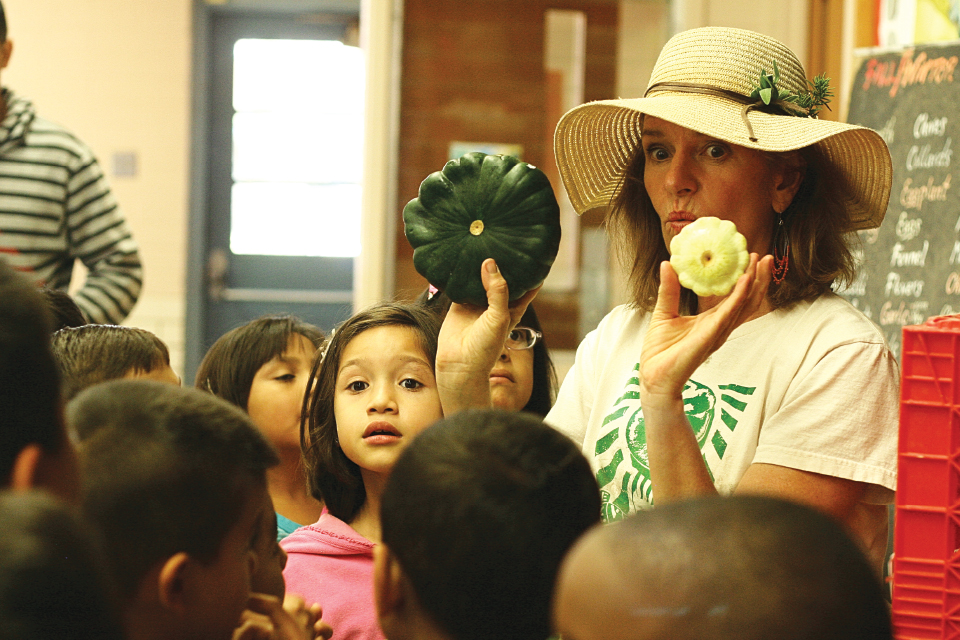The Sustainable Food Center

Most active people spend a great deal of time thinking about their nutrition and the best way to fuel their workouts: when to eat, how much to eat, what kinds of foods to eat, and the proper balance of nutrients. Austinite Amy Dolejs is one of those people. Her weekly workout routine typically consists of Krav Maga four times per week, a sprinkling of yoga, and the occasional 20-mile round trip bike commute to work. “When I think about food, I think about what is going to fuel my workouts, how I’m going to feel afterwards, and how it will help me recover,” she said. For Dolejs, getting the biggest bang for her nutritional buck involves a biweekly trip to the Sunset Valley Farmers’ Market. “I have the idea that if you eat food that’s in season and from local farmers, it’s richer in nutrients than food that has been sitting in a refrigerated truck for who knows how long,” she said.
Dolejs’ assertion about the nutritional value of locally grown food is spot on, according to Executive Director Ronda Rutledge of the Sustainable Food Center (SFC) in Austin. “The less distance our food travels, the more packed with nutrients it is, naturally,” she explained. Encouraging the community to think about where their food comes from has been the heart and soul of the SFC’s mission for over 35 years. The organization improves community access to locally grown food and teaches children and adults how to actively participate in a sustainable food system by growing, preparing and sharing their own food. According to Rutledge, “[The] SFC helps keep Austin fit and healthy by increasing access to nutritious, affordable, locally grown food.”
To that end, one of the SFC’s principle initiatives is Farm Direct, which provides access to local produce through farm-to-work, farm-to-school and farm-to-cafeteria programs. Also part of this initiative is a network of weekly farmers’ markets, which has expanded over the years to include four locations in the Austin area: downtown, Sunset Valley, the Triangle, and the YMCA at Highway 183 and 51st Street. The markets feature in-season, locally grown produce, meats, cheeses, and artisan products. Participating farms are located within a 150-mile radius of Austin, ensuring that minimal natural resources and nutritional value are expended in food transport. Each farm is also fully vetted by the SFC through site visits to ensure that sustainable practices are being used. As Dolejs pointed out, farmers often extend this open-door policy to customers as well: “Many of the farms that sell at the market actually have a standing invitation to visit their farm and see how they grow the food and raise the animals; I really love that.” Smaller farmers’ markets are held at Women, Infant and Children Programs (WIC) clinics and community centers in underserved areas around Austin, and all markets accept WIC vouchers and food stamps. These efforts ensure that the entire Austin community has affordable access to fresh, healthy food and that farmers have a regular, stable outlet for their products, thus strengthening the local economy—a win-win for all.
Having access to healthy food is only one step toward a healthier lifestyle, however. Not everyone has the knowledge or the time to prepare fresh, whole foods, and the prevalence of processed and prepackaged convenience food often facilitates unhealthy choices. The SFC tackles this challenge through The Happy Kitchen/La Cocina Alegre, a cooking and nutrition education program designed to teach Central Texans how to cook healthy, quick, and affordable meals. Participants also learn about eating seasonally, safe food-handling practices, and knife skills. Each week, the class has the opportunity to discuss their cooking successes and challenges, ask questions, and share their experiences with others, ultimately strengthening ties with their community while improving their health.
Recognizing the importance of forming healthy habits at an early age, the SFC has also taken an interest in the health of children in Central Texas, partnering with local elementary schools for its Sprouting Healthy Kids program. This initiative takes a three-pronged approach to encourage children to make healthy choices: working with partner schools to offer locally grown fruits and vegetables in cafeteria lunches, creating classroom lessons utilizing onsite gardens and farm and food information as learning aids, and providing an after-school program in which students can participate in hands-on gardening and cooking classes. Partner schools also host “Farm Day,” where students have the opportunity to meet local farmers, talk about food and nutrition, and taste new (and sometimes unusual) produce. In 2010, the SFC partnered with Marathon Kids, a local program that uses elementary schools to encourage kids to run 26.2 miles, to provide a physical fitness component to their program. Through classroom lessons and hands-on learning, the SFC hopes that students will be more likely to make choices that have a positive impact on their health and that of their families.
Everyone benefits from eating more healthfully, but there is also a powerful link between food and community. Dolejs is grateful to have made connections with local farmers: “You get to know people…It’s really important to me to know where my food is coming from, to trust the people that grow it.” She compared the markets to a town square where people can meet and make connections. Rutledge agreed with this comparison: “Austinites enjoy shopping at our network of SFC Farmers’ Markets as a way to be outside and active with friends and family—while also keeping dollars here in our local economy and supporting small to mid-scale farmers.”
Ultimately, the SFC hopes that its numerous programs will make the origin of our food more transparent and dispel the myth that eating healthy is time consuming and unaffordable. So the next time you start thinking about how to fuel your workouts, take a moment to consider where your food is coming from—and how eating locally and in season might help you build not only a stronger, healthier body but a stronger, healthier community as well.






